Electric heating radiators - types and features
Recently, the popularity of electric heating appliances has steadily increased in the European market. A similar choice is often made in our country, especially for residents of the private sector, because gasification is far from being present in all localities. Moreover, radiators are of particular popularity among electric appliances for heating, which this article is dedicated to.
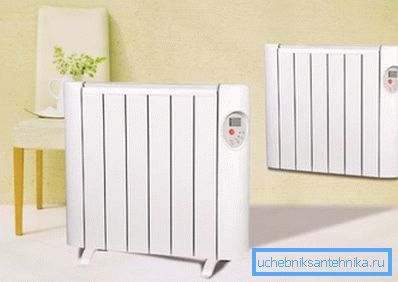
Types of radiators
The word radiator means “radiator”, which heats the surrounding space by radiating thermal energy or convection. As a result, in a room equipped with such a device, there is a constant heat exchange.
Accordingly, all existing models of these devices can be divided into two types:
- Oil radiators;
- Convectors.
Note! An electric radiator can be either stationary, mounted on a wall, or portable, which can be easily moved from place to place.
Below we take a closer look at their device and features.
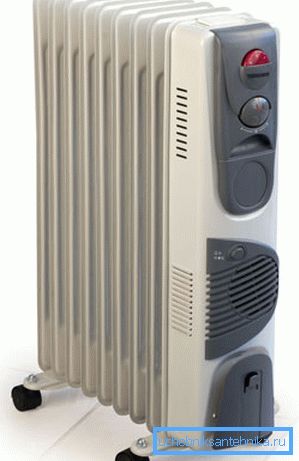
Oil radiators
Oil radiators work due to the interaction of several elements, the principle of heating is as follows:
- Copper and galvanized plates (electrodes) are placed in the electrolyte. When the device is connected to electricity, a current begins to flow through the electrodes, as a result of which the electrolyte heats up.
- Then, the resulting heat is transferred to the coolant, which is used as mineral oil.
- Since the oil has excellent heat dissipation and a much higher boiling point than water, it heats the surfaces of radiators to a high temperature.
Thanks to special temperature control systems, overheating of the coolant is excluded. The surface of the battery is usually ribbed, which allows to increase the area of the radiator.
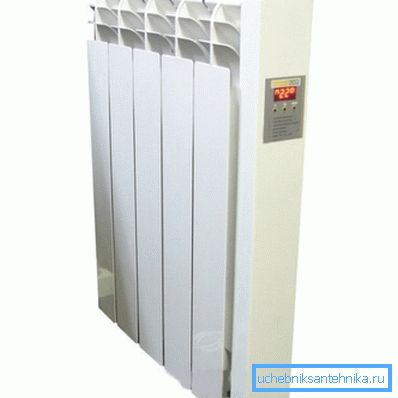
The case of radiators is often made of stainless steel material, for example, aviation aluminum. To completely eliminate the possibility of oxidation of the body, it is coated inside and outside with an oxide film. Because of this, the device is well tolerated even operation in rooms with high humidity.
It must be said that there are programmed models in which electronics are responsible for maintaining the heating temperature of the ambient air and the surface of the device itself, which also provides significant energy savings, therefore, despite the fact that the price of such devices is higher, their purchase is still profitable acquisition.
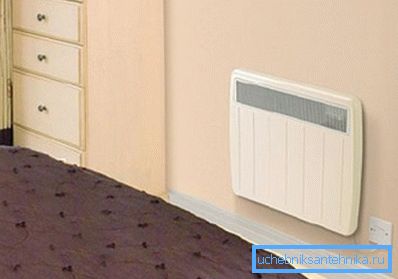
Convection Radiators
The principle of operation of convection radiators is quite simple - cold air passes through the device and hot air comes out. As the hot air cools with time, it goes down and heats up again in the radiator.
As a result, convection electric wall-mounted heating radiators, as, in fact, portable, consist of two main elements:
- Enclosures;
- The heating element located inside.
Outlets on the body are often at a slight angle relative to the vertical, as a result of which a warm air mass moves upwards along a parabolic path.
A wall-mounted electric convection radiator has one important advantage over oil machines - the heating temperature of the case does not rise above sixty degrees, therefore the risk of getting burns is excluded.
Oil radiators, as already mentioned above, can warm up to high temperatures, as a result of which they are considered to be traumatic. This property is very important if the house has children or pets.
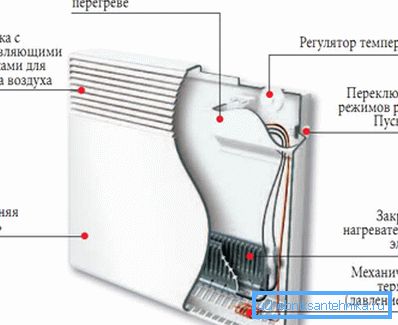
Depending on the type of element being heated, convection radiators differ in several types:
| Needle | Heater is a thin dielectric plate on which a heating chrome-nickel filament is applied, coated with an insulating varnish. The loops of this thread are located on both sides of the plate. A feature of this design is almost instantaneous heating. The convection of air in devices with a needle heater is carried out due to the special design of the case. Their advantages include low price. |
| Tubular | The heating element is made in the form of a tube with a nichrome thread installed. The space inside the tube is filled with heat-conducting insulator-insulator. To increase the efficiency of the heater, aluminum fins are fixed on the tube. Such heating elements heat up longer than the needle ones, but for that it is more durable. Among the shortcomings can be identified only crackling in the process of work, which can create some discomfort. |
| Monolithic | In contrast to the previous design, they work completely silently. In addition, these devices perform heating with minimal heat loss. True, the cost of such devices is the highest. |
Note! The lacquered thread in the needle heating elements is practically not protected from moisture, so these devices should not be used in rooms with high humidity.
As a result, we can conclude that the best option for convection heaters are devices with monolithic heating elements.
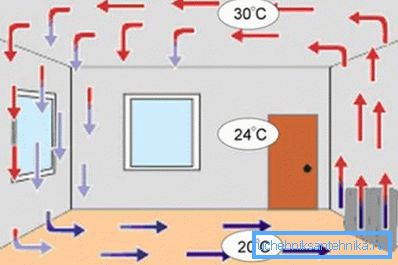
Features of heating with electric radiators
Merits
The use of electric radiators has many advantages:
- An electric radiator is an independent heating device that does not require piping and additional equipment, unlike water batteries.
- It will not be difficult for any home craftsman to assemble the electric radiator with his own hands, since all the work is to fix the heater on the wall and connect it to electricity.
- Ecological purity - heating occurs without the process of burning and emission of harmful substances into the atmosphere.
- In case of breakage of one of the radiators, there is no need to disconnect the other devices.
- Electric radiators provide rapid heating of the room.
- They have compact dimensions and attractive appearance.
- Extremely simple instruction manual that does not require any care of the device.
Note! Electric radiators can be used as an addition to the main heating system. For example, you can turn them on when the room is cold, and the centralized heating utilities have not turned on or have already turned off.
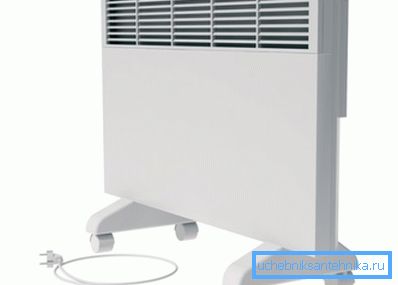
disadvantages
Despite all the advantages of these heating devices, they cannot be called ideal for the following reasons:
- The cost of electricity is quite high.
- The need for powerful wiring.
- In rural areas, power outages often occur.
For these reasons, in our country, electric radiators are used either where there is no possibility to equip gas heating, or as an additional source of heating.
Conclusion
Electric radiators are efficient and convenient heating devices, which have several advantages. However, it should be noted that the very operation of these devices is quite expensive, due to their high consumption of expensive electricity.
From the video in this article, you can pick up some additional information on this topic.